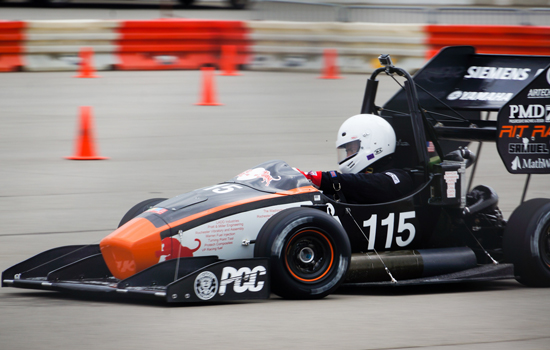RIT Formula Racing places in top 20
Team wins Continental Brake Award for ‘best-in-class’ design of brake system built ‘in house’
Hyungsuk Kang
RIT Formula Racing competed at it opening event in May at Michigan International Speedway. The team placed in the top-20 among 110 collegiate race teams.
RIT Formula Racing sped into a top-20 placement in its first competition this past May at Michigan International Speedway. It was the first event of the season for the team in its annual Formula SAE collegiate design and race competition season, and one of its best starts in several years. RIT was 14th overall among 110 international teams competing at the event, including universities representing Venezuela, Canada, Austria, Poland and Brazil as well as those from the U.S.
Taking high placements in skidpad, acceleration and autocross events, and running 16th in the demanding endurance race, RIT Racing also received the Continental Brake Award, given to a team with the best-in-class brake system for its vehicle.
The Formula team builds the entire system, except for brake calipers, in the machine shop and Brinkman Lab in RIT’s Kate Gleason College of Engineering. They are one of only a handful of national and international teams that designs and fabricates their own brakes, as well as the majority of the racecar’s parts, said Andrew Dodd, team lead, vehicle dynamics.
“We have our hands in making everything on the car,” said Dodd, a fifth-year industrial and systems engineering student from Syracuse, N.Y. “We are one of the only teams that make pretty much everything in-house. When we go to competitions, other teams ask us how we get a part made. We tell them we did it, and they often don’t believe it.”
Controlling the design of intricate parts such as the brakes and chassis are part of the team’s plan to put in place a competitive racecar that can hold its own—and win—against U.S. and European collegiate teams. This past year, RIT Racing focused on making the racecar lighter and building parts that enhanced its maneuverability on the track using data simulations of the track components they’d encounter.
“We found that a car that was light, that maximized cornering potential, not so much straight line acceleration, was the better way to go, by a lot,” Dodd explained, adding that it was becoming the trend adopted by top teams. “Other good teams were doing this, obviously we pay attention to the competition — but we don’t always just go with what they do. We try to prove it on our own.”
A single cylinder engine, rather than a four-cylinder, lightened the load by 30-40 pounds, Dodd said. Along with a lighter chassis made of composite materials rather than metals, and keeping several of the aerodynamic and turbo charger features from last year, the testing proved that RIT Racing was on track for success with a car that was both efficient and fast.
“Our goal was to increase the reliability of the car, keeping things simple and distilling everything to its best form,” he said.
They will be taking that knowledge into the next competition, scheduled for July 28–Aug. 2 at the Formula Student Germany event. The team has consistently placed among the top teams in the international competition.










